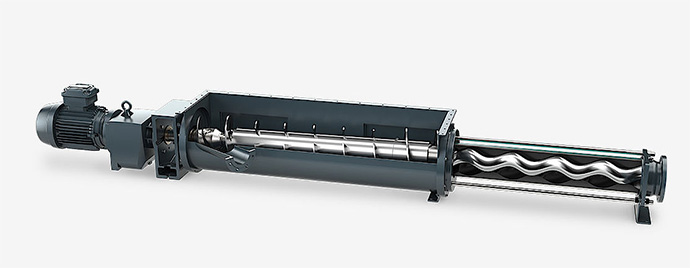NEMO® B.Max® biomass pump by NETZSCH robust and flexible in biogas production
Netsch’s NEMO® B.Max® biomass pump technology proves successful in biogas production thanks to high mixing performance and robustness.

The NEMO® B.Max® Mixing Pump is employed in biogas plants for continuous, pressure-stable, gentle and low-pulsation conveyance and mixing of various substrates
Photo by NETZSCH Pumpen & Systeme GmbH
The production of biogas requires continuous supply to the fermenter to ensure an uninterrupted fermentation process. NETZSCH has adapted its proven progressing cavity pump technology to meet these specific requirements. This technology allows flexible adjustment of the pump depending on the medium and the required performance. Depending on the design, pumps of this type achieve an output of up to 70 m³/h and a pressure of up to 48 bar. They are energy efficient, robust and flexible and can be individually upgraded with different accessories.
One advantage of the progressing cavity pump technology is that hardly any pulsation or strong shear forces occur which ensures gentle transport with stable pressure. This is important because the mixing of the substrate has a crucial influence on the efficiency of the fermentation process. That is why B.Max® was designed to support the homogenisation of the medium and a uniform biomass pulp. This allows fermentation bacteria and process heat to be distributed evenly throughout the substrate and reduces the formation of floating layers.
To achieve this, the pump is equipped with a position-optimised feed port which guides the recirculated mass into the mixing area against the direction of flow. This creates turbulence in the biomass which causes the individual materials to mix during feeding. This process is additionally supported by the coupling rod in the mixing chamber which is equipped with a screw conveyor. The screw ensures that the sometimes rather viscous biomass is reliably transported into the pump area. The offset segments of the mixing screw and their high thread pitch ensure that more substrate flows to the progressing cavity screw than the screw can transport away. The result is an intentional, controlled return flow which creates further turbulence in the material mixture and therefore its homogenisation.
High level of robustness
The biomass pump is fed through a large, rectangular feed hopper. The wide shape prevents clogging. For the same reason, the pump section is designed with as little dead space as possible so as not to offer any contact points for entwining or clogging. For cleaning or maintenance work, the housing has large revision openings allowing easy access to the inside without having to dismantle the entire pump.
The B.Max® is generally designed for a high level of robustness which can be increased further by different adaptations depending on the substrate. If, for example, a particularly high resistance to aggressive media is required, the hopper can also be coated and hardened. Furthermore, different types of steel or elastomer with different resistance categories are available for rotor and stator. This allows individual configuration of the pump according to the medium and the application requirements to achieve maximum lifetime with minimum maintenance effort.
From draining manure barrels to grinding
For operation with maximum efficiency and without malfunctions, the pump can be combined with other accessories such as dry running protection and overpressure protection. We also recommend installing additional metering pumps for recirculate or grinders. NETZSCH offers the corresponding devices, such as the M-Ovas® grinding system, to guarantee compatibility of all system components. These grinders are placed upstream of the conveying process, filtering out stones for example to prevent damage to the pump. But primarily they chop substances such as long fibres in the substrate, drastically reducing the risk of clogging.
Where larger volumes have to be filled or transferred, a rotary lobe pump can be used instead of the progressing cavity pump. NETZSCH has developed a highly robust solution for this area: The TORNADO® range which is resistant to clogging thanks to large openings while achieving a high flow rate. This, for example, allows manure barrels to be drained quickly and easily at up to 300 m³/h. The compact pistons and particularly the resistant material mixture as well as the durable belt drive of the T2 range ensure virtually maintenance-free operation and uncomplicated maintenance.
NEMO® B.Max® and further solutions will be showcased by NETZSCH at the Agritechnica Exhibition in Hannover/Germany from 8 to 14 November 2015 in hall 21 on stand G19.
For more information, please visit: www.netzsch-pumpen.de
News Categories
- » NEWS HOME
- » Automation & Robotics
- » Industry 4.0
- » Material Handling
- » Sensors
- » Quality & Testing
- » Machine Vision
- » Laser & Optics
- » Metalworking
- » Motion Control & Drives
- » Hydraulics & Pneumatics
- » Process Industry
- » Renewable Energy
- » Agriculture
- » Home & Office Furniture
- » Environmental Tech



